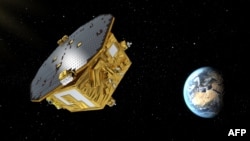When the most massive objects in the universe collide, you'd expect some fanfare. But these objects - black holes - are so dense not even light can escape, so there's a bit of a "if two black holes collide and no one sees it, did it happen?" vibe.
But there is one thing that's immune to their gravitational grasp and scientists have been dreaming about finding it for a century - until this year. They're called gravitational waves.
In 1916, Albert Einstein released his general theory of relativity, which posited the existence of gravitational waves - 'ripples' in the fabric of space-time. One hundred years later, this February, scientists at the Laser Interferometer Gravitational-Wave Observatory (LIGO) announced they had detected the first signatures of these cosmic disturbances. Last week, scientists with the Laser Interferometer Space Antenna (LISA) mission announced that their Pathfinder spacecraft protects the experiment well enough to detect gravitational waves from the universe’s most violent collisions - in space.
The case for space
Scientists detect gravitational waves by their effects on motionless objects called test masses. These objects must be perfectly still to measure vibrations smaller than an atom, that occur when a gravitational wave disturbs the mass. The purpose of the LISA Pathfinder mission was to test how well the spacecraft shielded two of these test masses from outside forces, in other words, anything that isn't a gravitational wave. If the masses are shielded properly, the only force acting on them would be gravity from the Sun and Earth, pulling the masses in a known orbit around the Sun. That is the closest you can get to standing still in space.
WATCH: An artist's representation of the trajectory of the LISA Pathfinder on its way to a relatively stable orbital path between the Earth and Sun. (ESA/ATG Medialab)
The test masses were shuttled to a location between the Earth and Sun, approximately 1.5 million kilometers from Earth, to escape terrestrial vibrations that would overshadow any gravitational wave effects. The spacecraft was switched on, and Paul McNamara, LISA Pathfinder Project Scientist, told VOA, “The performance was better than we had ever dreamt.… On the very first day we switched it on… we were absolutely delighted.”
And with the success of the Pathfinder mission, the European Space Agency is looking ahead to putting three satellites into this orbital sweet spot, where they will do the same job as the LIGO observatory here on Earth.
A second gravitational wave detector may seem unnecessary, since we already have LIGO. But when the new observatory, which will be known as eLISA, is launched, its location in space will be crucial for detecting waves from the collisions of supermassive black holes. Here’s why: before they collide, the black holes orbit each other every 15 minutes, causing large gaps between the peaks of gravitational waves. To measure the motion of test masses due to the passing waves, the distance between test masses must be large enough to see the wave peak in one then another.
To picture this, imagine you and a friend are each sitting in boats on the water very close together. If a large wave passes under your boats, you will both rise and fall at about the same time, so you might not realize that anything had changed. However, if you are farther apart, one of you will begin to rise before your friend, so it is obvious that a wave has passed. Gravitational waves are so large that the distance between the test masses needs to be on the order of millions of kilometers. This calls for a space-based observatory to house the test masses.
More is better
eLISA will detect waves that rise and fall much slower than LIGO can. Want to get an idea of how slow? In LIGO's case, those two boats we talked about earlier were over 3,000 kilometers apart.
eLISA’s boats will be millions of kilometers apart, easily detecting the slower gravitational waves.
As two black holes orbit each other, their orbits speed up as they're pulled closer and closer. This causes the gravitational waves to rise and fall faster and faster until the black holes merge. Once eLISA is operational in 2034, it will be able to detect the slower gravitational waves well in advance of Earth-based LIGO, which is tuned to the faster waves. “Having… two detectors running simultaneously gives us a whole wealth of information,” says McNamara. David Reitze, Executive Director of the LIGO Laboratory, adds, “It’ll really make for a much richer kind of gravitational wave astronomy.”
They proved elusive for a hundred years, but with two observatories, scientists can detect a wider range of gravitational waves. This allows scientists to study the very first black holes that formed in the universe and how they helped shape the luminous structures we see today.











